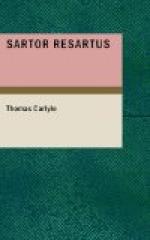To the First Chapter, which turns on Paradise and Fig-leaves, and leads us into interminable disquisitions of a mythological, metaphorical, cabalistico-sartorial and quite antediluvian cast, we shall content ourselves with giving an unconcerned approval. Still less have we to do with “Lilis, Adam’s first wife, whom, according to the Talmudists, he had before Eve, and who bore him, in that wedlock, the whole progeny of aerial, aquatic, and terrestrial Devils,”—very needlessly, we think. On this portion of the Work, with its profound glances into the Adam-Kadmon, or Primeval Element, here strangely brought into relation with the Nifl and Muspel (Darkness and Light) of the antique North, it may be enough to say, that its correctness of deduction, and depth of Talmudic and Rabbinical lore have filled perhaps not the worst Hebraist in Britain with something like astonishment.
But, quitting this twilight region, Teufelsdrockh hastens from the Tower of Babel, to follow the dispersion of Mankind over the whole habitable and habilable globe. Walking by the light of Oriental, Pelasgic, Scandinavian, Egyptian, Otaheitean, Ancient and Modern researches of every conceivable kind, he strives to give us in compressed shape (as the Nurnbergers give an Orbis Pictus) an Orbis Vestitus; or view of the costumes of all mankind, in all countries, in all times. It is here that to the Antiquarian, to the Historian, we can triumphantly say: Fall to! Here is learning: an irregular Treasury, if you will; but inexhaustible as the Hoard of King Nibelung, which twelve wagons in twelve days, at the rate of three journeys a day, could not carry off. Sheepskin cloaks and wampum belts; phylacteries, stoles, albs; chlamydes, togas, Chinese silks, Afghaun shawls, trunk-hose, leather breeches, Celtic hilibegs (though breeches, as the name Gallia Braccata indicates, are the more ancient), Hussar cloaks, Vandyke tippets, ruffs, fardingales, are brought vividly before us,—even the Kilmarnock nightcap is not forgotten. For most part, too, we must admit that the Learning, heterogeneous as it is, and tumbled down quite pell-mell, is true concentrated and purified Learning, the drossy parts smelted out and thrown aside.
Philosophical reflections intervene, and sometimes touching pictures of human life. Of this sort the following has surprised us. The first purpose of Clothes, as our Professor imagines, was not warmth or decency, but ornament. “Miserable indeed,” says he, “was the condition of the Aboriginal Savage, glaring fiercely from under his fleece of hair, which with the beard reached down to his loins, and hung round him like a matted cloak; the rest of his body sheeted in its thick natural fell. He loitered in the sunny glades of the forest, living on wild-fruits; or, as the ancient Caledonian, squatted himself in morasses, lurking for his bestial or human prey; without implements, without arms, save the ball of heavy Flint,




